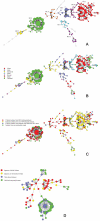Resistance of Asian Cryptococcus neoformans serotype A is confined to few microsatellite genotypes
- PMID: 22427900
- PMCID: PMC3302784
- DOI: 10.1371/journal.pone.0032868
Resistance of Asian Cryptococcus neoformans serotype A is confined to few microsatellite genotypes
Abstract
Background: Cryptococcus neoformans is a pathogenic yeast that causes cryptococcosis, a life threatening disease. The prevalence of cryptococcosis in Asia has been rising after the onset of the AIDS epidemic and estimates indicate more than 120 cases per 1,000 HIV-infected individuals per year. Almost all cryptococcal disease cases in both immunocompromised and immunocompetent patients in Asia are caused by C. neoformans var. grubii. Epidemiological studies on C. neoformans in pan-Asia have not been reported. The present work studies the genetic diversity of the fungus by microsatellite typing and susceptibility analysis of approximately 500 isolates from seven Asian countries.
Methodology/principal findings: Genetic diversity of Asian isolates of C. neoformans was determined using microsatellite analysis with nine microsatellite markers. The analysis revealed eight microsatellite complexes (MCs) which showed different distributions among geographically defined populations. A correlation between MCs and HIV-status was observed. Microsatellite complex 2 was mainly associated with isolates from HIV-negative patients, whereas MC8 was associated with those from HIV-positive patients. Most isolates were susceptible to amphotericin B, itraconazole, voriconazole, posaconazole, and isavuconazole, but 17 (3.4%) and 10 (2%) were found to be resistant to 5-flucytosine and fluconazole, respectively. Importantly, five Indonesian isolates (approximately 12.5% from all Indonesian isolates investigated and 1% from the total studied isolates) were resistant to both antifungals. The majority of 5-flucytosine resistant isolates belonged to MC17.
Conclusions: The findings showed a different distribution of genotypes of C. neoformans var. grubii isolates from various countries in Asia, as well as a correlation of the microsatellite genotypes with the original source of the strains and resistance to 5-flucytosine.
Conflict of interest statement
Figures

Similar articles
-
Antifungal susceptibility testing with YeastONE™ is not predictive of clinical outcomes of Cryptococcus neoformans var. grubii fungemia.Med Mycol. 2021 Nov 3;59(11):1114-1121. doi: 10.1093/mmy/myab046. Med Mycol. 2021. PMID: 34374784
-
High Prevalence of HIV-Related Cryptococcosis and Increased Resistance to Fluconazole of the Cryptococcus neoformans Complex in Jiangxi Province, South Central China.Front Cell Infect Microbiol. 2021 Nov 1;11:723251. doi: 10.3389/fcimb.2021.723251. eCollection 2021. Front Cell Infect Microbiol. 2021. PMID: 34790585 Free PMC article.
-
In vitro antifungal susceptibility profiles and genotypes of 308 clinical and environmental isolates of Cryptococcus neoformans var. grubii and Cryptococcus gattii serotype B from north-western India.J Med Microbiol. 2011 Jul;60(Pt 7):961-967. doi: 10.1099/jmm.0.029025-0. Epub 2011 Mar 10. J Med Microbiol. 2011. PMID: 21393452
-
Trend of pediatric cryptococcosis in a tertiary care centre and review of literature.Indian J Med Microbiol. 2023 May-Jun;43:18-29. doi: 10.1016/j.ijmmb.2022.11.002. Epub 2022 Dec 2. Indian J Med Microbiol. 2023. PMID: 36464534 Review.
-
Cryptococcus neoformans Genotypic Diversity and Disease Outcome among HIV Patients in Africa.J Fungi (Basel). 2022 Jul 15;8(7):734. doi: 10.3390/jof8070734. J Fungi (Basel). 2022. PMID: 35887489 Free PMC article. Review.
Cited by
-
The Predominance of a Specific Genotype of Cryptococcus neoformans var. Grubii in China and Japan.Comput Math Methods Med. 2022 Aug 5;2022:8162096. doi: 10.1155/2022/8162096. eCollection 2022. Comput Math Methods Med. 2022. Retraction in: Comput Math Methods Med. 2023 Jul 19;2023:9861240. doi: 10.1155/2023/9861240. PMID: 36035289 Free PMC article. Retracted.
-
A Short-Tandem-Repeat Assay (MmySTR) for Studying Genetic Variation in Madurella mycetomatis.J Clin Microbiol. 2021 Feb 18;59(3):e02331-20. doi: 10.1128/JCM.02331-20. Print 2021 Feb 18. J Clin Microbiol. 2021. PMID: 33298608 Free PMC article.
-
Geographically structured populations of Cryptococcus neoformans Variety grubii in Asia correlate with HIV status and show a clonal population structure.PLoS One. 2013 Sep 3;8(9):e72222. doi: 10.1371/journal.pone.0072222. eCollection 2013. PLoS One. 2013. PMID: 24019866 Free PMC article.
-
Increasing trend of fluconazole-non-susceptible Cryptococcus neoformans in patients with invasive cryptococcosis: a 12-year longitudinal study.BMC Infect Dis. 2015 Jul 22;15:277. doi: 10.1186/s12879-015-1023-8. BMC Infect Dis. 2015. PMID: 26194004 Free PMC article.
-
Importance of Resolving Fungal Nomenclature: the Case of Multiple Pathogenic Species in the Cryptococcus Genus.mSphere. 2017 Aug 30;2(4):e00238-17. doi: 10.1128/mSphere.00238-17. eCollection 2017 Jul-Aug. mSphere. 2017. PMID: 28875175 Free PMC article.
References
-
- Bovers M, Hagen F, Boekhout T. Diversity of the Cryptococcus neoformans-Cryptococcus gattii species complex. Revista Iberoamericana de Micologia. 2008;25:S4–12. - PubMed
-
- Lin X, Heitman J. The biology of the Cryptococcus neoformans species complex. Annual Review of Microbiology. 2006;60:69–105. - PubMed
-
- Park BJ, Wannemuehler KA, Marston BJ, Govender N, Pappas PG, et al. Estimation of the current global burden of cryptococcal meningitis among persons living with HIV/AIDS. AIDS. 2009;23:525–530. - PubMed
Publication types
MeSH terms
Substances
LinkOut - more resources
Full Text Sources
Other Literature Sources
Medical

